Sauerkraut: Easy Probiotic Recipe
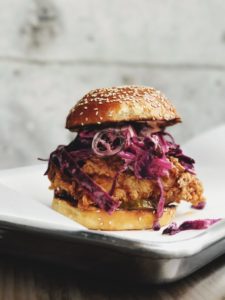 While I think there is certainly a place for probiotics in a pill form, and often recommend them as part of a treatment plan, there is a special magic in homemade fermented foods, such as sauerkraut, kim chi, kombucha, fermented root vegetables like carrots or daikon. There is a complexity of good bacteria in fermented foods that you just can’t get in a pill. The following simple sauerkraut recipe is a great starting place for making homemade gut-healing probiotics.
While I think there is certainly a place for probiotics in a pill form, and often recommend them as part of a treatment plan, there is a special magic in homemade fermented foods, such as sauerkraut, kim chi, kombucha, fermented root vegetables like carrots or daikon. There is a complexity of good bacteria in fermented foods that you just can’t get in a pill. The following simple sauerkraut recipe is a great starting place for making homemade gut-healing probiotics.
Why do I want to eat fermented foods?
Our grandparents and theirs made kraut, kefir, pickles and the like for a variety of reasons. I doubt they were thinking about replenishing the bacteria in their guts and thus, improving their digestion and increasing the accessibility of nutrients from all the foods they ate, but that was the happy outcome. They likely fermented foods to extend the life of their harvests, to make those gorgeous summer veggies last through the harsh winters. They also likely knew that a pile of kraut on top of some fried eggs or a steak to be ridiculously delicious.
Sandor Katz, the great granddaddy of the modern fermentation movement in the US tells us:
"Chlorine is put in water to kill the bacteria and it continues to kill some bacteria after we drink the water. Antibiotic drugs – there are a lot of individuals whose lives have been saved because of them, and I may be one of them — but it seems that it is widely agreed that antibiotics are also wildly over prescribed.
And even more so than the human population, livestock is continually being pumped up with antibiotics because it makes animals grow faster. There’s a residue of all antibiotic manufacturing and usage that accumulates in the water, so all of us are ingesting [antibiotics] every day, no matter how pristine the source of the water we are drinking. If you compound that with all the antibacterial chemicals being used as soaps and cleaning products, we are all constantly being subjected to all of these chemicals that kill bacteria."
Given the number of antibiotics in our modern lives, eating good bacteria not only helps replenish what is killed, fermented foods also help fight off bad bacteria. Maintaining a healthy gut keeps us healthier overall.
If your digestion is a concern, if you have diarrhea or constipation, acid reflux or sour stomach, if you’re having trouble losing or gaining weight, or otherwise feel like your digestion could need a boost, simple homemade ferments could be a wonderful addition to your diet.
The benefits of probiotics and fermented foods are clear:
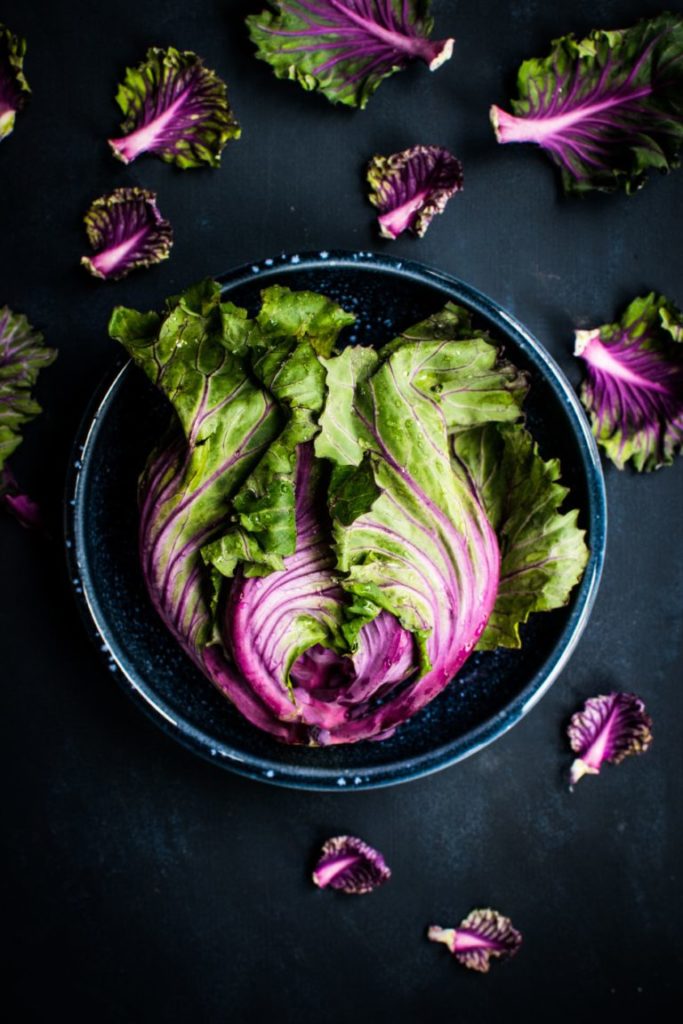
So much of your overall health is based on the health of your gut. Healthy gut flora support optimal immune system function, digestion, nutrient absorption and mood.
Health Benefits of Fermented Foods:
- Improving intestinal tract health:
- Leaky gut, or increased intestinal permeability, is a growing concern in industrialized countries.
- Without healthy gut flora, leaky gut and its symptoms will only continue.
- Fermented foods help build a healthy gut environment by providing the life-sustaining bacteria we need.
- Eating foods high in lactic-acid bacteria and their byproducts helps protect the gut, through their ability to neutralize harmful bacteria.
- Enhance the immune system, synthesizing and enhancing the bioavailability of nutrients
- Reduce symptoms of lactose intolerance, decreasing the prevalence of allergy in susceptible individuals
- Reducing risk of certain cancers
- Support proper metabolism and utilization of folate, pyroxidine, B vitamins, riboflavin and biotin depending on the strains of bacteria present.
- These vitamins are key to a balanced mood and energy, and to keeping cancers and heart disease away, by supplying the building blocks of the methylation detox cycle (a really important thing in the body)
- Fermented foods are rich in enzymes that improve and aid digestion, making all the nutrients in our food more accessible
It’s cheap and easy to ferment foods at home and the health benefits are amazing. When digestion is improved, you can absorb more nutrients. It makes simple sense to me.
-
- Cabbage is rich in the amino acid L-glutamine.
- Glutamine has been known to play an important role in gut function, immune system regulation, and other essential processes in the body, especially in times of stress.
- Glutamine has been used to treat gastrointestinal issues such as stomach ulcers, IBS, Crohn's, acid reflux and colitis.
- My patients have reported significant improvement in emotional issues including depression, irritability, insomnia, anxiety, moodiness and ADHD with L-glutamine use.
- Cabbage is rich in the amino acid L-glutamine.
- Fermenting is also fun and easy, and a jar of homemade fermented goodness makes a great holiday gift.
A simple recipe
I’m a busy gal, so I like to make lots of kraut at once. Use less cabbage if you want, just adjust the ingredients to suit.
I also love to add things like shredded carrot, turnips, beets, onions and garlic (rich in healthy sulfur), seaweed (get your iodine on), greens.
Mixing green and red cabbage makes for a pink kraut which is really pretty.
Adding fruit can be yummy: apples are my favorite and a fall classic. Herbs and spices such as caraway, dill or celery seeds are fabulous.
I have done a lot of experiments and invite you to do the same!
Ingredients:
-
- 3 lbs of organic cabbage: white, red, napa. Fresher is better, such as from your garden or the farmer’s market.
- 2 tablespoons of sea salt for 3 lbs cabbage
- Note: it’s super important to use really good quality noniodized sea salt. I love Celtic Sea Salt or Himalayan Pink Sea Salt. It’s more expensive, but well worth it.
- 3 very clean quart size wide mouth mason jars with the two part lids
- A large ceramic or glass bowl - metal leaves a funny taste in my experience, and plastic contains toxins
- You may need some room-temperature filtered water to top your sauerkraut off
 Directions:
Directions:
1. Start with super-clean hands, cutting board, knife, mason jars. You don’t want to be introducing a bunch of yucky bacteria into the kraut.
2. Take the two outer leaves off your cabbage, compost those, wash the cabbage well.
3. Cut it up in to the size and shape you like to eat. I like longer, thinner strands. I usually use a knife, but a mandoline is a good option. Cut the heart out and discard.
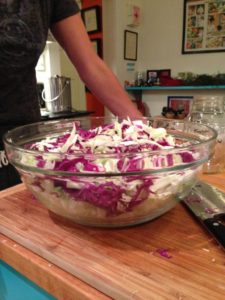
4. Put the cabbage, and any yummy add-on like caraway seeds, in the bowl with the sea salt and mix well.
5. Let the cabbage and salt mixture sit for at least 30-60 minutes. Don't have time to wait? Don't worry! Just add the cabbage and salt together in the jar, and add some filtered water on top. Done is better than some story about "perfect" - right?!
6. The cabbage will get soft, but the salt should keep it from getting mushy. You’ll notice that water will come out of the cabbage, which is the goal of adding the salt and letting it sit. You can squeeze the cabbage with your hands if you need more water to come out.
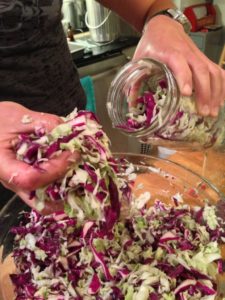
7. With those nice clean hands put the cabbage in the mason jar in small layers, pushing it down with your fist or a wooden tool as you go, packing it in tight.
8. Pour the water from the big bowl in, with the goal of having about a half inch of water above the cabbage, either from the vegetable itself or by adding filtered water as needed. Leave 1-2 inches of room between the top of the cabbage and the top of the jar.
9. Put the lid on tight with your hands and put it in the cupboard for 3-4 days. Once the lid gets hard, and doesn’t pop down when you press on it, it’s done. Open it up carefully, over the sink, as it’s likely to fizz over - which is a good thing.
You can put it in the refrigerator now, which slows the fermentation.
Finally, if you take a nice big forkful out of the jar and put it in your mouth, do NOT put the fork back in the jar! The bacteria from your mouth can contaminate the whole container. Cleanliness is the name of the game with fermenting. Remember: if the kraut or other ferment tastes, smells or feels off, or has mold or other spots growing on it, it's best not to eat it. Trust your gut.
I do my best to eat fermented foods every day. I love to put sauerkraut on a burger or salad, on eggs in the morning. It’s easy once you get into the swing of it, and make fermented foods a part of your life. Other great ferments include kimchi, kefir, sourdough bread, fermented carrots, pickles, fermented coconut milk/yogurt, natto, kombucha, salsa, beverages like homemade ginger beer and so many other yummy treats.
Happy fermenting!
To your health,
Victoria
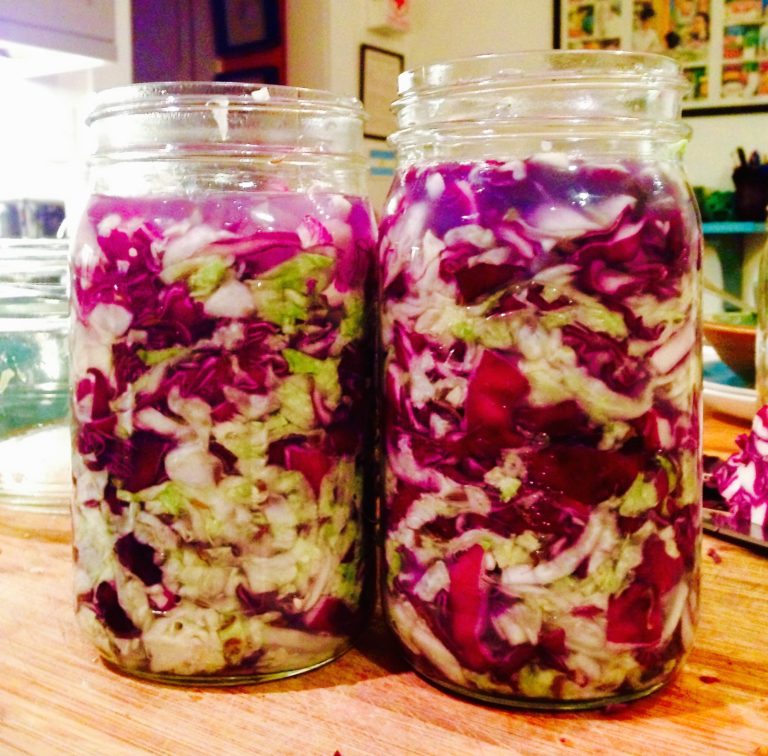
References
Parvez, Malik, Ah Kang, Kim (2006) Probiotics and their fermented food products are beneficial for health. Journal of Applied Microbiology. Volume 100, Issue 6, pages 1171–1185, June 2006
Tuohy, Probert, Smejkal, Gibson (2006) Using probiotics and prebiotics to improve gut health. Drug Discov Today. 2003 Aug 1;8(15):692-700.

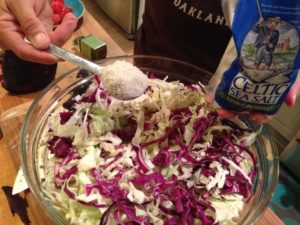 Directions:
Directions: